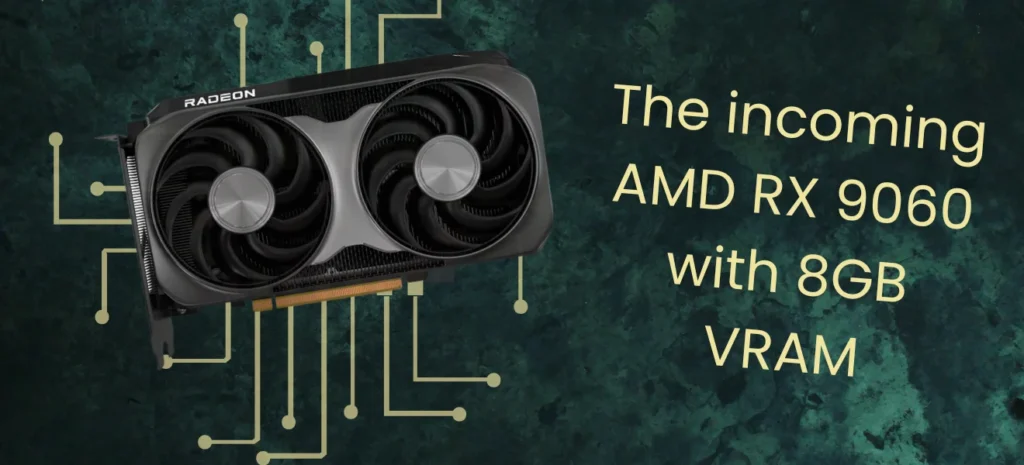AMD has once again stirred up the waters of the gaming world. This time it officially launches the AMD Radeon RX 9060 non-XT (for the sake of a possible fond impression, we put “non-xt”), a graphics card built on the RDNA 4 architecture, which is supposed to appeal primarily to owners of cheaper gaming PCs. It has a catch, however, because instead of the expected 12GB or 16GB of VRAM, it only delivers 8GB of GDDR6 memory. And in 2025, this is a topic that divides the gaming community.
AMD reveals Radeon RX 9060 non-XT specs
The novelty offers 28 Compute Units (CUs), which corresponds to 1,792 stream processors and 64 ROP units. This is complemented by 112 texture mapping units. Compared to the more powerful AMD Radeon RX 9060 XT, which has 32 Compute Units and 2,048 stream processors, this is a noticeably weaker version. The base is still the same Navi 44 XL chip, but selected from a lower production run (the so-called lower bin).
Memory options include 8 GB of GDDR6 on a 128-bit memory bus at 18 Gbps, giving a throughput of 288 GB/s. The power consumption of the entire card is 132 W TDP, with the manufacturer recommending a minimum 450 W power supply.
| Technical specifications of the AMD Radeon RX 9060 non-XT | |
|---|---|
| Chip | Radeon RX 9060 non-XT |
| Boost frequency | 2 990 MHz |
| Stream processors | 1792 |
| Memory Size | 8 GB GDDR6 |
| Memory speed | 18 Gbp/s |
| Memory bus | 128-bit |
| Recommended PSU | 450 W |
| Consumption | 132 W |
| Outputs | DisplayPort 2.1a | HDMI 2.1b |
| Cooling | Active (2 fans) |
| Power connector | 1 x 8-pin |
| PCIe version | PCIe 5.0 x16 |
| Infinity cache | 32 Mb |
Availability and sales of AMD Radeon RX 9060 non-XT
And now the important information but a bit sadder, namely that you can’t buy AMD Radeon RX 9060 non-XT separately. AMD offers this model exclusively to manufacturers of finished PC builds, so it will appear exclusively in pre-installed gaming PCs from select partners. The unveiling took place on 5. august 2025 and the first kits are expected to go on sale in the coming weeks.
Why won’t AMD Radeon RX 9060 non-XT be sold separately ?
AMD has decided not to sell the AMD Radeon RX 9060 non-XT separately, as the card exclusively targets manufacturers of finished gaming PCs. This move allows them to offer a cheaper build with the new RDNA 4 graphics, at the same time AMD will empty the stock of less popular 8GB chips and avoid direct comparison with competitors in reviews. So it’s a strategic move that protects sales of the more powerful RX 9060 XT models while strengthening business relationships with OEM partners.
For gamers who want to build their own gaming rig, the Radeon RX 9060 XT model, introduced back on June 5, 2025, remains on offer with slightly more powerful specs and a slightly bigger price tag.
Why only 8GB of VRAM in 2025?
This is where opinions diverge. On the one hand, AMD claims that for 1080p gaming at high settings, 8 GB of VRAM is sufficient. On the other hand, many gamers and experts alike point out that modern titles, often less optimized, can drain 8 GB quickly. Meanwhile, Nvidia and Intel already offer at least 10 GB and 12 GB of memory for their new releases.
How does the AMD Radeon RX 9060 non-XT perform in practice ?
According to AMD’s official tests, the card manages the following results on ultra settings in native 1080p:
All without using frame generation technologies, so at first glance it looks like really sufficient performance, but these are just a few games and we’ll have to wait for more tests and comparisons from practice.
Will the AMD Radeon RX 9060 non-XT be a blockbuster or a forgotten card?
Only the market will tell everything, so we recommend keeping an eye out for official statements from AMD on this card. If the finished gaming PCs with this card will be priced very attractively, AMD Radeon RX 9060 non-XT may find its fans, especially among gamers who don’t need 1440p or 4K resolution. However, if manufacturers set the price too high, it may repeat the fate of previous 8GB models that were left lying in warehouses.
What do you think? Is 8GB of VRAM still acceptable in 2025, or should the lower limit be at least 12GB? Of course, the more the better, but we all know that behind everything, look for the price. Let us know your opinion, it seems that this topic will still stir up a lot of discussion among AMD and Nvidia fans.

